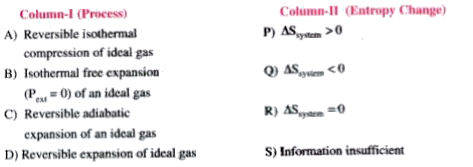For the reaction, Ag2O(s)⇔2Ag(s)+12O2(g)ΔH,ΔSandT are 40.63 kJ mol−1,108.8JK−1mol−1and373K respectively. Free energy change ΔG of the reaction will be _____Solution in Telugu
The correct Answer is:0
ΔG=ΔH−TΔS
=40.43−373×108.81000=0.476KJ≈0
Topper's Solved these Questions
- BOOK - AAKASH SERIESCHAPTER - CHEMICAL THERMODYNAMICSEXERCISE - PRACTICE SHEET (EXERCISE- I) (LEVEL- I (MAIN) STRAIGHT OBJECTIVE TYPE QUESTIONS)17videos
CHEMICAL THERMODYNAMICS
- BOOK - AAKASH SERIESCHAPTER - CHEMICAL THERMODYNAMICSEXERCISE - PRACTICE SHEET (EXERCISE- I) (LEVEL- II (ADVANCED) STRAIGHT OBJECTIVE TYPE QUESTIONS)3videos
CHEMICAL THERMODYNAMICS
- BOOK - AAKASH SERIESCHAPTER - CHEMICAL THERMODYNAMICSEXERCISE - LECTURE SHEET (EXERCISE-III) (LEVEL - II (ADVANCED) MATRIX MATCHING TYPE QUESTIONS)2videos
CHEMICAL THERMODYNAMICS
- BOOK - AAKASH SERIESCHAPTER - CHEMICAL THERMODYANMICS EXERCISE - Questions For Descriptive Answers28videos
CHEMICAL THERMODYANMICS
- BOOK - AAKASH SERIESCHAPTER - ELECTRON MIGRATION EFFECTS EXERCISE - QUESTIONS FOR DESCRIPTIVE ANSWERS10videos
ELECTRON MIGRATION EFFECTS
Similar Questions
The intensive property among these quantities is
01:33View SolutionOne mole of an ideal monoatomic gas at temperature T and volume 1L expands to 2L against a constant external pressure of one atm under adiabatic conditions, then final temperature of gas will be:
05:59View Solution 02:15View Solution
02:15View SolutionHow does heat of neutralisation value change with the chemical nature of acid and base?
01:04View SolutionHyperconjugation effect is also termed as 'no bond resonance'. Why?
01:22View SolutionCalculate the free energy change for the following reaction at 300 K. 2CuO_((s)) rarr Cu_(2)O_((s))+(1)/(2)O_(2(g)) Given Delta H = 145.6 kJ mol^(-1) and Delta S = 116.JK^(-1) mol^(-1)
View SolutionFor a reaction, Ag_(2)O(s)hArr2Ag(s)+(1)/(2)O_(2)(g) DeltaH,DeltaS and T are 40.63 kJ mol^(-1) , 108.8 J K^(-1)mol^(-1) and 373.3K respectively. Predict the feasibility of the reaction:
07:09View SolutionFor the reaction, Ag_(2)O(s)hArr2Ag(s)+(1)/(2)O_(2)(g) DeltaH,DeltaS and T are 40.63 kJ mol^(-1) , 108.8 JK^(-1)mol^(-1) and 373.4K respectively. Free energy change DeltaG of the reaction will be:
03:24View SolutionThe temperature at which the reaction : Ag2O(s)→2Ag(s)+1/2O2(g) is at equilibrium is ……..,
Given ΔH=30.5KJmol−1
and ΔS=0.5KJmol−1 :01:38View SolutionFor the reaction Ag_(2)O(s)rarr 2Ag(s)+1//2O_(2)(g) the value of Delta H=30.56 KJ mol^(_1) and Delta S = 66 JK^(-1)mol^(-1) . The temperature at which the free energy change for the reaction will be zero is :-
02:13View SolutionFor a reaction
Ag2O(s)⇔2Ag(s)+12O2(g)
the entropy and enthalpy change are respectively 60JK−1and30kJ. The given reaction will attain equilibrium at04:08View SolutionThe values of Delta H and Delta S in vaporisation of water at 1 atm pressure are 40.63 " kJ mol"^(-1) and 108.8 J. K^(-1). " mol"^(-1) respectively. At what temperature the free energy change of the reaction will be zero ? What will be the sign of Delta G below that temperature ?
02:13View SolutionDelta H and Delta S for the reaction, Ag_(2)O(s)to 2A(s)+(1)/(2)O_(2)(g) , are 30.56 kJ mol^(-1) and 66.0 J mol^(-1) respectively. Calculate the temperature at which this reaction will be at equilibrium. Predict whether the forward reaction will be favoured above or below this temperature.
02:42View SolutionThe Delta H and Delta S " for " 2 Ag_(2)O (s) rarr 4Ag(s) + O_(2) (g) are given + 61.18 kJ mol^(-) and + 132 JK^(-1) mol^(-1) respectively. Above what temperature will be reaction be spontaneous?
01:24View SolutionAt the temperature T(K) for the reaction X_(2)O_(4) (l) rarr 2XO_(2)(g) Delta U = x kJ mol^(-1), Delta S = y JK^(-1) mol^(-1) . Gibbs energy change for the reaction is (Assume X_(2)O_(4), XO_(2) are ideal gases) Delta U = x kJ mol^(-1), Delta S = y JK^(-1) mol^(-1)
01:06View Solution

